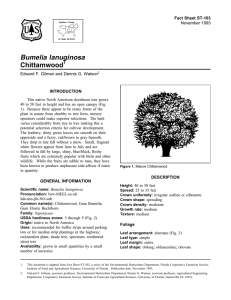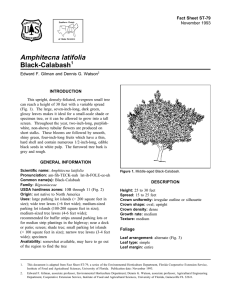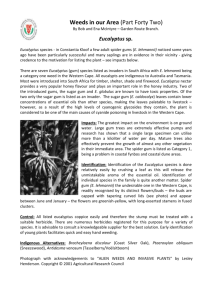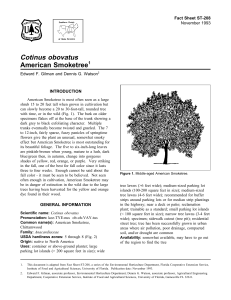Eucalyptus ficifolia Red-Flowering Gum Fact Sheet ST-239 1
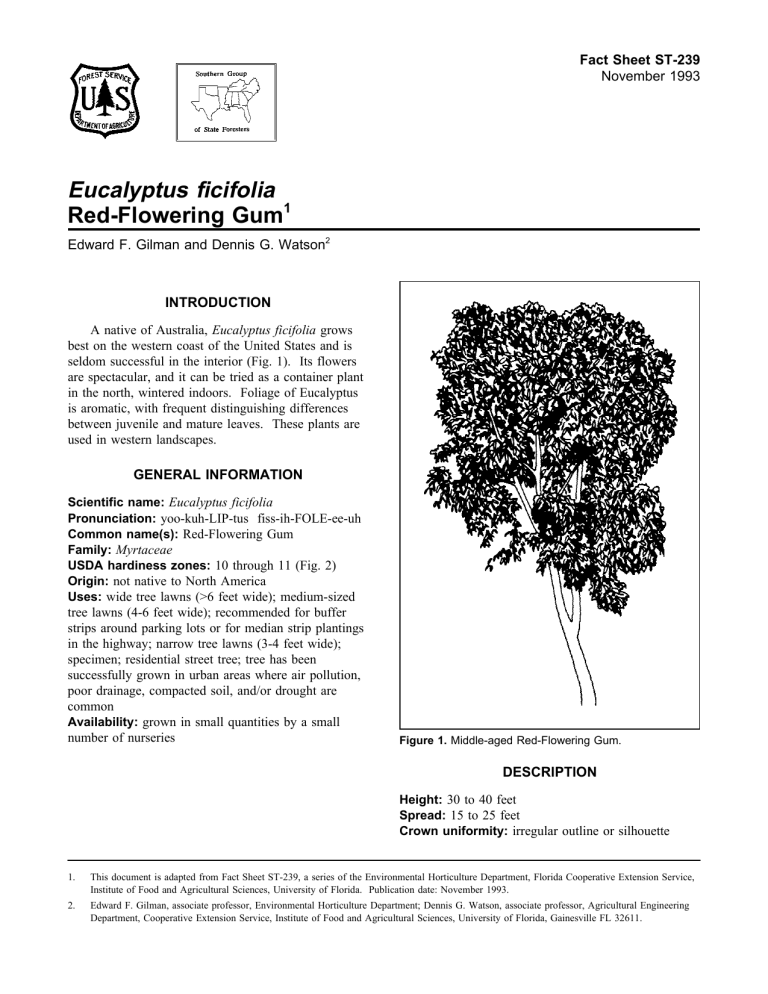
Fact Sheet ST-239
November 1993
Eucalyptus ficifolia
Red-Flowering Gum
1
Edward F. Gilman and Dennis G. Watson
2
INTRODUCTION
A native of Australia, Eucalyptus ficifolia grows best on the western coast of the United States and is seldom successful in the interior (Fig. 1). Its flowers are spectacular, and it can be tried as a container plant in the north, wintered indoors. Foliage of Eucalyptus is aromatic, with frequent distinguishing differences between juvenile and mature leaves. These plants are used in western landscapes.
GENERAL INFORMATION
Scientific name: Eucalyptus ficifolia
Pronunciation: yoo-kuh-LIP-tus fiss-ih-FOLE-ee-uh
Common name(s): Red-Flowering Gum
Family: Myrtaceae
USDA hardiness zones: 10 through 11 (Fig. 2)
Origin: not native to North America
Uses: wide tree lawns (>6 feet wide); medium-sized tree lawns (4-6 feet wide); recommended for buffer strips around parking lots or for median strip plantings in the highway; narrow tree lawns (3-4 feet wide); specimen; residential street tree; tree has been successfully grown in urban areas where air pollution, poor drainage, compacted soil, and/or drought are common
Availability: grown in small quantities by a small number of nurseries
Figure 1. Middle-aged Red-Flowering Gum.
DESCRIPTION
Height: 30 to 40 feet
Spread: 15 to 25 feet
Crown uniformity: irregular outline or silhouette
1.
This document is adapted from Fact Sheet ST-239, a series of the Environmental Horticulture Department, Florida Cooperative Extension Service,
Institute of Food and Agricultural Sciences, University of Florida. Publication date: November 1993.
2.
Edward F. Gilman, associate professor, Environmental Horticulture Department; Dennis G. Watson, associate professor, Agricultural Engineering
Department, Cooperative Extension Service, Institute of Food and Agricultural Sciences, University of Florida, Gainesville FL 32611.
Eucalyptus ficifolia -- Red-Flowering Gum Page 2
Figure 2. Shaded area represents potential planting range.
Crown shape: round
Crown density: moderate
Growth rate: fast
Texture: medium
Foliage
Leaf arrangement: alternate (Fig. 3)
Leaf type: simple
Leaf margin: entire
Leaf shape: lanceolate
Leaf venation: pinnate
Leaf type and persistence: broadleaf evergreen; evergreen; fragrant
Leaf blade length: 2 to 4 inches
Leaf color: green
Fall color: no fall color change
Fall characteristic: not showy
Flower
Flower color: red
Flower characteristics: spring flowering; summer flowering; very showy
Fruit
Fruit shape: oval; round
Fruit length: 1 to 3 inches
Fruit covering: dry or hard
Fruit color: brown; green
Fruit characteristics: does not attract wildlife; no significant litter problem; persistent on the tree; showy
Trunk and Branches
Trunk/bark/branches: grow mostly upright and will not droop; showy trunk; should be grown with a single leader; no thorns
Pruning requirement: requires pruning to develop strong structure
Breakage: susceptible to breakage either at the crotch due to poor collar formation, or the wood itself is weak and tends to break
Current year twig color: brown; reddish
Current year twig thickness: thin
Eucalyptus ficifolia -- Red-Flowering Gum Page 3
USE AND MANAGEMENT
Propagation of Eucalyptus is by seed, using ripe seed capsules taken off trees.
Pests
Pests of Eucalyptus include psyllids, aphids, mealybugs, scales, mites, caterpillars and borers.
Spraying with soap solution or appropriate chemical sprays will often suffice to control all but the borers.
Borer damage may require the cutting out and destroying of infested stems and the removal of dying plants. Psyllids disfigure the tree and can be quite a problem.
Diseases
Eucalyptus are resistant to armillaria root rot and to verticillium wilt. They are susceptible to powdery mildew and to Phytophthora cinnamoni and
Phytophthora lateralis.
Leaf spot and crown gall are Eucalyptus’ major disease problems. Prune infected twigs and branches, and be sure to keep dead leaves and fruit cleaned up as plant refuse is usually the source of leaf spot disease.
Figure 3. Foliage of Red-Flowering Gum.
Culture
Light requirement: tree grows in full sun
Soil tolerances: clay; loam; sand; slightly alkaline; acidic; well-drained
Drought tolerance: high
Other
Roots: surface roots are usually not a problem
Winter interest: no special winter interest
Outstanding tree: not particularly outstanding
Invasive potential: No entries found.
Verticillium wilt susceptibility: not known to be susceptible
Pest resistance: very sensitive to one or more pests or diseases which can affect tree health or aesthetics
